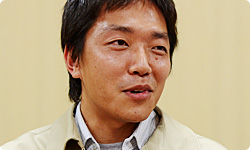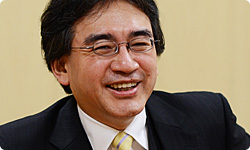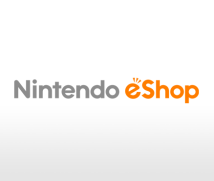5. Recreating the Game Boy Afterimage
Moving on to Tanaka-san, we're finally ready to discuss the Virtual Console. How did you come to work on it?
To be honest, I don't really know! (laughs) One day my boss just told me to head it up.
Working on the Virtual Console wasn't as simple as making a universal emulator for feeding the binary (file data) and knocking them out, right? What exactly do you do?
They're basically the same as before, but when something isn't quite right, we correct it. The Game Boy system made use of the characteristics of its LCD. For example, it would make characters and so on flash to represent them as translucent, but when you do that on the Nintendo 3DS system, it just doesn't work, so we adjust things like that.
A lot has changed since back then with regard to the way something flashing looks and the response speed of liquid crystal, so you're not just moving around the same images. How do you determine which titles to use?
Basically, the Nintendo eShop region managers mull it over among themselves, saying "I want that one game for North America," or "I want this title for Europe," or "This software is necessary in Japan." It gets a bit messy sometimes because a game that is still popular in America may never have been sold in Japan! (laughs) Once the roster begins to take shape among the shop managers, we estimate the practicability and production costs of those titles and consider the scheduling involved.
I suppose there are easy titles to make as well as hard ones.
Roughly speaking, action games and puzzlers are easy to make, while you have to check a lot of spots in RPGs, which takes a lot of time.
When the original programming doesn't result in something that looks like the original, you go in and fix every detail, right? How many titles will be available on the Virtual Console?
There will be six titles (six for Japan, four in Europe) when the shop opens.11 We plan to add others later. 11Six titles for Japan when the shop opens: The following six titles are planned for release for Japan: Rockman World (Capcom), Kirby's Dream Land (Nintendo), Baseball (Nintendo), Phantasm (Jaleco), Downtown Special: Kunio-kun no Jidaigeki dayo Zenin Shugo! (Arc System Works), and Super Mario Land (Nintendo). For Europe, the following four titles from Nintendo will be available for launch: Super Mario Land, Tennis, Alleyway, and The Legend of Zelda: Link's Awakening DX.
There are some modes you added to the Virtual Console out of a playful spirit, aren't there?
Yes. I was born in 1980, so I was part of that generation in which everyone was dying to have a Game Boy system. But I couldn't get my parents to buy me one. (laughs)

The Game Boy system came out in 1989, so you were about 9.
Yeah. About that time, everyone was getting hooked on Super Mario Land 12 and Tetris.13 12Super Mario Land: An action game released for the Game Boy system in 1989 in Japan. 13Tetris™: A puzzle game released for the Game Boy system in 1989.
Back then, a game system that you could carry around was a revolutionary invention for children.
Absolutely. So in realising the Virtual Console for the Nintendo 3DS system, I had a longing for certain characteristics. I wanted to recreate the atmosphere of the games as faithfully as possible. For example, the Game Boy system's LCD was a little greenish at first.
A sort of yellow-green.
And I even wanted to recreate that afterimage in Super Mario Land when Superball Mario throws a ball. (laughs)
Huh? That too?!
Yeah! (laughs) I included an extra mode with the old colouring and afterimages, so you'll think, "Oh, it was just like this!"
Did you compare it to the old game?
Yeah. I thought there might be a slight difference in how long the afterimage sticks around. (laughs)
(laughs) Like the afterimage needs to be a little stronger?
Yeah. (laughs) But if I went overboard, it would be hard to play on the Nintendo 3DS system, so I made something playable that also brings back those old memories to a certain extent. Another extra mode is a display mode for playing at the original resolution. Usually, the graphics are blown up to display in accordance with the Nintendo 3DS system's screen, but you can also play at the resolution of the original Game Boy system. However, the Nintendo 3DS system's resolution is higher, so it only shows up as a little window in the centre of the Nintendo 3DS system's upper screen! (laughs)
But it's pleasing the moment it does.
I can't help but think it looks great.
You even recreate that feeling of the liquid crystal set back a little from the Game Boy system's screen cover. I love that dedication to something some might consider pointless. (laughs)

Yeah. (laughs) I wanted to recreate as faithfully as possible how the LCD was just behind the screen cover.
The key is to have it set back just a little.
And I even recreated the way the red LED on the left-hand side of the screen cover would grow a little faint when the power started running low. I don't know if anyone will like that, but I paid attention to that as well. (laughs)
(laughs)
It’s sort of like you're saying, "Good thing you put me in charge, huh?"
But I wasn't the only one. Actually, one other person from the Game Boy generation participated in this project. We had different ideas of the Game Boy system, so we disagreed about a lot.
Your personal impressions didn't match up?
Right. Like when it came to the greenish LCD and afterimage. I brought in an actual Game Boy system and said, "There! See?" as we tried various approaches. (laughs)
Sounds fun.
And while it has a big impact on gameplay, this time you can stop the game anytime you want and do it over as often as you want.
That's different from the Wii system's Virtual Console.
Yes. With the Wii console, you can't save partway through and play over and over again. However, since there was also a battery life issue back then, I figured many people -myself included - were often unable to play a game all the way to the end. And old games were really difficult!
They were hard on the players.
Yeah, it would be too bad if people bought something from the Virtual Console for the first time, found it too difficult, and gave up. I hope people will make use of this function, which allows them to save anytime and play parts over again, in order to beat games that they never could before. Actually, I had never cleared Super Mario Land, so I used this function in playing it again and again, and after two times through, I noticed the Stage Select function for the first time! (laughs)
You were born right in the middle of the Game Boy generation but didn't know about that function in Super Mario Land until working on this project.
Yeah. I bet stuff like that is in other games as well, so I hope people will take notice of such things!
